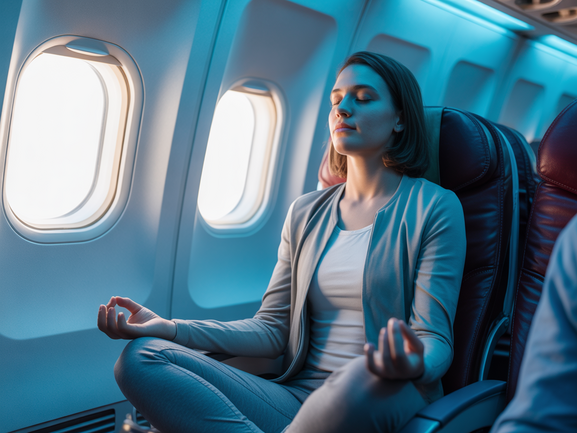Meditation for Travelers: 7 Mindful Techniques to Stay Zen On-the-Go
Are you tired of feeling scattered and stressed during your travels? Whether you’re a business executive rushing between meetings or a digital nomad constantly changing time zones, maintaining inner peace while traveling can seem impossible. However, with the right meditation techniques for travelers, you can transform any journey into an opportunity for mindfulness and renewal.
Traveling disrupts our routines, challenges our comfort zones, and often leaves us feeling disconnected from our centered selves. But what if I told you that the very act of traveling could become your greatest meditation teacher? Let’s explore how to cultivate mindfulness while traveling and discover practical techniques that work anywhere, anytime.
Why Traditional Meditation Fails During Travel
Most meditation practices assume you have a quiet space, consistent schedule, and familiar environment. Unfortunately, travel throws all of these assumptions out the window. Moreover, time constraints, jet lag, and unfamiliar surroundings can make traditional sitting meditation feel more stressful than peaceful.
This is precisely why we need specialized travel meditation techniques that work with the realities of modern travel, not against them. The key is adapting mindfulness practices to fit your mobile lifestyle rather than struggling to maintain rigid routines.
7 Proven Meditation Techniques for Travelers
1. The Airport Breathing Technique
Transform waiting time into mindfulness time with this simple yet effective technique:
- Find a comfortable seat in the departure lounge
- Place one hand on your chest, one on your belly
- Breathe in for 4 counts, hold for 4, exhale for 6
- Focus on the hand rising and falling on your belly
- Continue for 5-10 minutes
This technique helps counteract the stress of crowded airports while preparing your nervous system for the journey ahead.
2. Mindful Walking Meditation
Perfect for layovers and exploring new destinations, walking meditation keeps you grounded while moving:
- Walk at a slower pace than usual
- Focus on the sensation of each step
- Notice the rhythm of your movement
- When your mind wanders, gently return to the physical sensations of walking
This practice is particularly beneficial for business travelers who spend long hours sitting during flights.
3. The 3-3-3 Grounding Technique
When feeling overwhelmed in a new environment, use this quick grounding practice:
- Name 3 things you can see
- Name 3 things you can hear
- Name 3 things you can physically feel
This technique instantly brings you back to the present moment and can be done anywhere, from hotel rooms to busy streets.
4. Jet Lag Recovery Meditation
Combat the disorienting effects of jet lag with this specialized technique:
- Lie down comfortably in your accommodation
- Visualize your body adjusting to the new time zone
- Breathe deeply while imagining golden light synchronizing your internal clock
- Practice for 10-15 minutes before your intended bedtime
Research from the Sleep Foundation shows that mindfulness practices can significantly improve sleep quality after long flights.
5. In-Flight Meditation
Make the most of your flight time with these airplane-friendly techniques:
- Use noise-canceling headphones or earplugs
- Practice progressive muscle relaxation from head to toe
- Focus on your breath while visualizing your destination
- Try the body scan technique, mentally checking in with each part of your body
These practices not only pass time but also help you arrive feeling more refreshed and centered.
6. Hotel Room Sanctuary
Create a peaceful space wherever you stay:
- Choose a corner of your room as your meditation spot
- Use a travel-sized cushion or simply sit on the bed
- Dim the lights or use an eye mask
- Practice loving-kindness meditation, sending good wishes to fellow travelers
This technique helps you establish a sense of home and routine in unfamiliar environments.
7. Mindful Eating While Traveling
Transform meals into meditation opportunities:
- Eat slowly and deliberately
- Notice colors, textures, and flavors
- Pay attention to hunger and fullness cues
- Express gratitude for the food and experience
This practice not only enhances your travel experience but also helps maintain healthy eating habits on the road.
Building Consistency in Your Travel Meditation Practice
The key to successful meditation for travelers lies in flexibility and consistency. Rather than forcing yourself into rigid schedules, focus on these strategies:
Start Small: Even 5 minutes of daily practice can make a significant difference. Furthermore, shorter sessions are easier to maintain during busy travel schedules.
Use Technology Wisely: Download meditation apps that work offline, ensuring you can practice even without internet connectivity.
Create Triggers: Link your meditation practice to existing travel routines, such as meditating right after checking into a hotel or before meals.
Be Flexible: Accept that some days will be more challenging than others. Additionally, remember that even brief moments of mindfulness count as practice.
The Science Behind Travel Meditation
Research published in the Journal of Health Psychology demonstrates that regular meditation practice can reduce travel-related stress by up to 40%. Moreover, mindfulness techniques have been shown to:
- Improve sleep quality in new environments
- Reduce anxiety about travel disruptions
- Enhance immune function during travel
- Increase overall travel satisfaction
These benefits make meditation an essential tool for any frequent traveler’s wellness toolkit.
Common Challenges and Solutions
Let’s address the most common obstacles travelers face when trying to maintain a meditation practice:
Challenge: “I don’t have time to meditate while traveling.”
Solution: Integrate mindfulness into existing activities like walking, eating, or waiting. Even 2-3 minutes of conscious breathing can be beneficial.
Challenge: “It’s too noisy and distracting.”
Solution: Use noise as part of your practice. Instead of fighting sounds, acknowledge them and return to your breath. This builds resilience and adaptability.
Challenge: “I feel self-conscious meditating in public.”
Solution: Practice subtle techniques like mindful breathing or the

